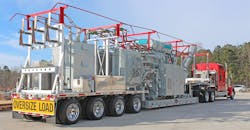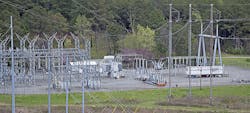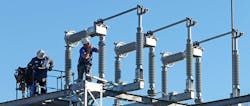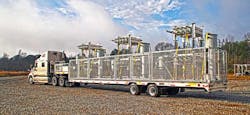Severe weather continues to be one of the primary, and most costly, causes of power outages for utilities. According to a 2012 Congressional Research Service report, weather-related power outages cost the U.S. economy $25 to $55 billion annually. Coupled with the demands of maintaining aging U.S. grid infrastructure, resiliency and reliability have become a critical challenge for utilities operating today’s power grid.
Increasing the resilience and reliability of the grid is dependent on the ability to minimize the frequency and duration of both planned and unplanned utility outages. Whether it be routine equipment maintenance or the impact of catastrophic storm damage, utilities need to have the flexibility to react quickly and methodically, minimizing total outage costs and end-customer infliction.
Meeting Utility’s Evolving Needs with Mobile Solutions
With technological advancements and an increasing population, the demand for electric power is changing. As the power grid grows more complex, shifting from a centralized model to one that offers greater efficiency by integrating renewable energy generation, proactive utilities are seeking ways to confront the challenges surrounding disaster recovery, power stability management, and maintenance efficiency by investing in high-voltage mobile substation and application specific equipment. These are designed to act as interim grid connections, rapidly restoring service to areas subjected to power supply issues.
Deployed 35 MVA Mobile Substation 230 kV x 25 kV
Mobile solutions can play a vital role in addressing:
- Outages caused by weather and other natural disasters
- Planned maintenance / construction projects
- Substation capacity demands
- Equipment failures
- Sabotage and cyber attacks
Custom mobile substations and specific application trailers provide utilities a complete modular, engineered solution. They can include the switchgear, breakers, emergency or station power supply, a compact high-power-density transformer and enhancing cooling capabilities, as well as other high voltage equipment. When needed, the mobile trailer system can be readily moved on location, enabling rapid temporary power restoration to end-customers by acting as a back-up to any damaged or out-of-service substation equipment.
Achieving Future Resilience
Weather and natural disasters are the main cause of electrical outages, and their impact is only expected to continue to grow overtime. While most natural disasters typically have a larger effect on the power lines leading to and from the substation, severe thunderstorms and tornados can directly harm substation operations and equipment, creating a need for a temporary backup power source.
The majority of present-day U.S. electric transmission and distribution lines were constructed in the 1950s and 1960s, surpassing their 50-year life expectancy by over a decade. To address this issue, many utilities are placing significant priority in the investment towards newer, more innovative energy infrastructure and technology that can enhance and harden long-term power grid resiliency and capacity during times of emergency outages. In contrast to the chaos of a natural disaster recovery scenario, planned maintenance of substations are strategically scheduled around storm season, ensuring that proper back-up energy resources are utilized where needed most.
Whether the outage scenario be imminent or planned, utilities can adopt mobile solutions to provide a reliable and steady source of backup power. As utility needs have evolved, their need and use of mobile solutions has intensified. While a 2006 DOE report to Congress estimated that about 600 mobile transformers were in use or available for use, Newton Evans Research now estimates the numbers of mobile transformers in the U.S. to be approximately 1,500 units as of year-end 2017.
Making a Proactive Plan
According to a 2014 Harris Poll on behalf of GE, millions of Americans are willing to pay an additional $10 per month to ensure the grid is more reliable with 52% becoming frustrated when they’re without power for an hour or less. This highlights the importance for utilities to take a proactive stance in adopting resiliency enabling assets like mobile solutions to support their customers’ power supply demands.
While initial investment costs may be a concern, the consequential financial impact of a sustained outage could be catastrophic. According to Information Technology Intelligence Consulting research, over 98% of large enterprises with more than 1,000 employees say a single hour of downtime costs their company over $100,000. Of even more significance, nearly one in three indicate that the hour of downtime costs over $1 million. The message is clear, in this case, that prolonged periods of downtime are costly and unwelcomed. For utilities, there is significant value in the ownership of mobile substation or application specific trailers, as the demand for reliable power supply will only continue to grow.
When choosing a mobile solutions provider, there are a few important factors to consider:
- Selecting Quality Equipment
Utilities should do thorough industry research to learn about potential manufacturers that offer equipment solutions that best fit their needs. Also, make sure the manufacturer is able to provide the latest technologies and a high level of customization.
Mobile solutions are typically engineered to specification, so the ability to customize is crucial. Tailor-made mobile solutions provide electric utility companies with the resources and equipment to solve their unique requirements and limitations.
- Variety of Mobile Application Products
Utilities should choose a manufacturer equipped with a variety of mobile trailer expertise and manufacturing experience. Each mobile trailer solution plays a different role in the power supply process, and they are subject to a utility’s unique operating conditions. Some of the most common trailer designs include:
- Mobile substations
- Capacitor trailers
- Circuit switcher trailers
- Circuit breaker trailers
- Switch trailers
- Regulator trailers
Mobile Capacitor Bank Trailer
- After-Sales Support
Lastly, utilities should look for manufacturers with 24/7 customer care support backed by an extensive field service support team of quality substation technicians, experienced in the adjustment and commissioning of all substation equipment. Further, they should seek out manufacturers with short lead times on spare parts for emergency support to ensure quick restoration in the event of an outage.
Mobile 115 kV, 550 kV BIL Circuit Breaker & Capacitor Bank Trailer
After-sales support is a critical component of the sales process that is often overlooked. This piece plays an important role in customers’ overall levels of post-purchase satisfaction. Partnering with the right manufacturer can have a significant financial and operational impact when problems or equipment needs arise.
To learn more about Southern States’ mobile innovations category and how they can help solve your unique reliability needs, take a moment to download their brochure here.
Sponsored By:





